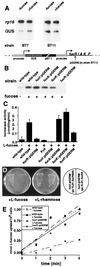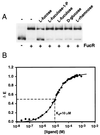A molecular sensor that allows a gut commensal to control its nutrient foundation in a competitive ecosystem
- PMID: 10449780
- PMCID: PMC22296
- DOI: 10.1073/pnas.96.17.9833
A molecular sensor that allows a gut commensal to control its nutrient foundation in a competitive ecosystem
Abstract
Little is known about how members of the indigenous microflora interact with their mammalian hosts to establish mutually beneficial relationships. We have used a gnotobiotic mouse model to show that Bacteroides thetaiotaomicron, a component of the intestinal microflora of mice and humans, uses a repressor, FucR, as a molecular sensor of L-fucose availability. FucR coordinates expression of an operon encoding enzymes in the L-fucose metabolic pathway with expression of another locus that regulates production of fucosylated glycans in intestinal enterocytes. Genetic and biochemical studies indicate that FucR does this by using fucose as an inducer at one locus and as a corepressor at the other locus. Coordinating this commensal's immediate nutritional requirements with production of a host-derived energy source is consistent with its need to enter and persist within a competitive ecosystem.
Figures




Similar articles
-
A model of host-microbial interactions in an open mammalian ecosystem.Science. 1996 Sep 6;273(5280):1380-3. doi: 10.1126/science.273.5280.1380. Science. 1996. PMID: 8703071
-
How host-microbial interactions shape the nutrient environment of the mammalian intestine.Annu Rev Nutr. 2002;22:283-307. doi: 10.1146/annurev.nutr.22.011602.092259. Epub 2002 Apr 4. Annu Rev Nutr. 2002. PMID: 12055347 Review.
-
Mapping arm-DNA-binding domain interactions in AraC.J Mol Biol. 2001 Apr 6;307(4):1001-9. doi: 10.1006/jmbi.2001.4531. J Mol Biol. 2001. PMID: 11286551
-
A hybrid two-component system protein of a prominent human gut symbiont couples glycan sensing in vivo to carbohydrate metabolism.Proc Natl Acad Sci U S A. 2006 Jun 6;103(23):8834-9. doi: 10.1073/pnas.0603249103. Epub 2006 May 30. Proc Natl Acad Sci U S A. 2006. PMID: 16735464 Free PMC article.
-
Bacteroides thetaiotaomicron in the gut: molecular aspects of their interaction.Dig Liver Dis. 2007 Aug;39(8):707-12. doi: 10.1016/j.dld.2007.04.003. Epub 2007 Jun 29. Dig Liver Dis. 2007. PMID: 17602905 Review.
Cited by
-
Barcoded overexpression screens in gut Bacteroidales identify genes with roles in carbon utilization and stress resistance.Nat Commun. 2024 Aug 5;15(1):6618. doi: 10.1038/s41467-024-50124-3. Nat Commun. 2024. PMID: 39103350 Free PMC article.
-
Role of tenofovir dipivoxil in gut microbiota recovery from HBV-infection induced dysbiosis.BMC Microbiol. 2024 Sep 20;24(1):359. doi: 10.1186/s12866-024-03457-4. BMC Microbiol. 2024. PMID: 39304810 Free PMC article.
-
Strain-specific strategies of 2'-fucosyllactose, 3-fucosyllactose, and difucosyllactose assimilation by Bifidobacterium longum subsp. infantis Bi-26 and ATCC 15697.Sci Rep. 2020 Sep 28;10(1):15919. doi: 10.1038/s41598-020-72792-z. Sci Rep. 2020. PMID: 32985563 Free PMC article.
-
Mucin-type O-glycans and their roles in intestinal homeostasis.Glycobiology. 2013 Sep;23(9):1026-37. doi: 10.1093/glycob/cwt045. Epub 2013 Jun 10. Glycobiology. 2013. PMID: 23752712 Free PMC article. Review.
-
Delivery of a mucin domain enriched in cysteine residues strengthens the intestinal mucous barrier.Sci Rep. 2015 May 14;5:9577. doi: 10.1038/srep09577. Sci Rep. 2015. PMID: 25974250 Free PMC article.
References
-
- Savage D C. Annu Rev Microbiol. 1977;31:107–133. - PubMed
-
- Van der Waaij D. Annu Rev Microbiol. 1989;43:69–87. - PubMed
-
- Araneo B A, Cebra J J, Beuth J, Fuller R, Heidt P J, Midvedt T, Nord C E, Nieuwenhuis P, Manson W L, Pulverer G, et al. Zentralbl Bakteriol. 1996;283:431–465. - PubMed
-
- Kühn R, Löhler J, Rennick D, Rajewski K, Müller W. Cell. 1993;75:263–274. - PubMed
Publication types
MeSH terms
Substances
Associated data
- Actions
Grants and funding
LinkOut - more resources
Full Text Sources
Other Literature Sources
Molecular Biology Databases

